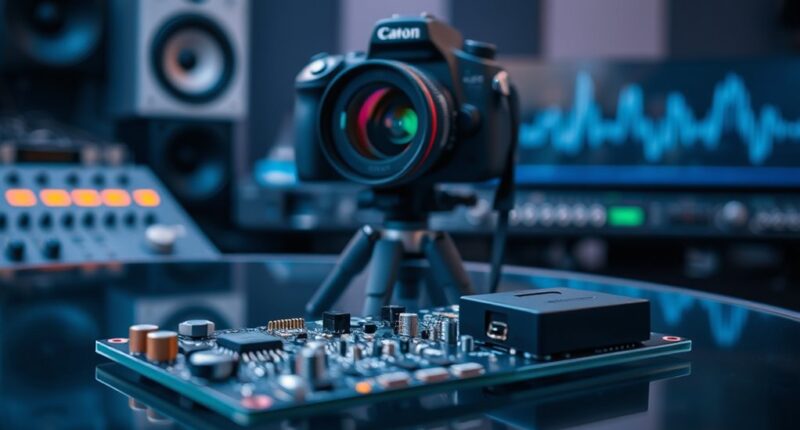Mechanical royalties turn small payments from song plays or sales into big earnings through high volume and precise management. Every time your song is reproduced—on physical copies, downloads, or streaming—you earn a tiny amount. When this adds up across millions of plays or sales, pennies become significant payouts. Proper licensing, tracking, and new technology help guarantee you’re paid accurately. Keep going, and you’ll see how these small streams build impressive revenue.
Key Takeaways
- Royalties are calculated per unit sold or stream, translating small payments into significant earnings through volume.
- Licensing agreements and rights management ensure accurate reporting, enabling proper distribution of mechanical royalties.
- Digital platforms and streaming services generate royalties based on usage, turning individual plays into cumulative income.
- Technology like automated systems and blockchain enhances transparency, efficiency, and accuracy in royalty payouts.
- Consistent high-volume sales and streams amplify small payments, transforming pennies into substantial revenue over time.
Understanding Mechanical Royalties: The Basics

Understanding mechanical royalties is fundamental if you want to grasp how artists and songwriters earn from their work. These royalties are payments made for the reproduction of songs, whether on CDs, vinyl, digital downloads, or streaming services. Every time a song is reproduced, a mechanical royalty is generated, serving as a source of income for creators. The amount paid isn’t based on sales price but is typically calculated per unit or stream, depending on the medium. This guarantees that songwriters and rights holders get compensated whenever their music is reproduced, regardless of how the recording is distributed. Color accuracy plays a crucial role in ensuring that the reproduced music sounds true to the original recording, enhancing listener experience. Mechanical royalties form a core part of the income stream for many creators, making it vital to understand how these payments are generated and who manages them. Additionally, the rise of generative AI in media production is beginning to influence how music and sound are created, potentially impacting future royalty calculations and distribution methods. Understanding royalty management processes is essential for artists and rights holders to ensure proper compensation and to adapt to evolving technologies. Moreover, modern safety features in electronic devices like heated mattress pads help prevent overheating and ensure safe operation, which can be an important consideration for producers handling electronic media equipment.
How Mechanical Royalties Are Calculated

To understand how mechanical royalties are calculated, you need to contemplate different royalty rate structures and how they apply to your sales. You’ll also want to look at how units sold—whether physical copies or digital downloads—impact your earnings. You should also consider the type of sale as digital and physical sales are often calculated differently, which can affect your total royalties. Additionally, understanding sound design can be useful if financial support arrangements arise from your music career. Recognizing the relationship dynamics involved in your collaborations can help ensure fair compensation and clear agreements.
Royalty Rate Structures
How are mechanical royalties actually calculated? It depends on the royalty rate structure set by licensing agreements. Typically, these structures include:
- Percentage of Sales: You receive a fixed percentage of the retail or wholesale price of each copy sold.
- Per-Unit Rate: A set fee paid for each unit sold, regardless of price.
- Sliding Scale Rates: The royalty rate varies based on sales volume or price tiers, increasing as sales grow.
Each structure impacts your earnings differently. For example, a percentage rate ties your payout to sales volume, while per-unit rates offer predictable income per sale. Understanding these structures helps you anticipate your earnings and negotiate better deals.
Units Sold Calculation
When calculating mechanical royalties based on units sold, you multiply the number of copies sold by the per-unit rate or apply the appropriate percentage to the sales value, depending on your licensing agreement. This straightforward method guarantees you’re compensated for each copy distributed, whether physical or digital. For physical sales, like CDs or vinyl, you typically use a fixed per-unit rate set by your license. For digital or downloadable sales, the calculation might involve a percentage of the sale price. It’s important to keep accurate sales records and understand your licensing terms, as they determine which method applies. Fathers often serve as role models by guiding character and behavior in various contexts. By carefully tracking units sold, you can ensure you receive the correct royalty payments for your work.
Digital vs. Physical
Digital and physical sales are calculated differently when it comes to mechanical royalties. For digital, royalties are based on streams or downloads, often a set percentage of revenue. Physical sales, like CDs or vinyl, rely on units sold, with rates set per album or track. Imagine:
- Counting each digital download or stream as a tiny building block, adding up over time.
- Tracking every physical album that leaves the store, like a tally of tangible treasures.
- Applying different royalty rates depending on the format, ensuring fair pay for each sale type.
- The royalty calculation methods vary significantly, reflecting the distinct ways consumers purchase music today.
Additionally, the exponential growth of streaming has shifted how royalties are distributed, making it crucial for artists to understand these distinctions. The disparity between formats means your earnings depend on whether fans are purchasing a vinyl or streaming a song online. Understanding these nuances helps you see how each sale type impacts your payout. Moreover, incorporating various home decor elements into your workspace can boost creativity and productivity, which is beneficial for artists and creators navigating these revenue streams.
The Role of Song Sales and Streaming in Royalties

Song sales and streaming have become the primary ways artists earn mechanical royalties today. When your music is purchased or streamed, you earn a royalty based on each transaction. Imagine a simple flow:
| Method | Revenue Generation |
|---|---|
| Physical Sales | Fans buy CDs or vinyl, generating royalties |
| Digital Sales | Downloads from stores like iTunes |
| Streaming | Plays on Spotify, Apple Music, etc. |
Each time your song is purchased or streamed, a small royalty is calculated and accumulated. These royalties are then collected and distributed to you. Streaming, in particular, has expanded your reach, providing continuous income as listeners enjoy your music repeatedly. The more your songs are played, the more pennies turn into significant payouts over time. Additionally, understanding mechanical royalties helps artists maximize their earnings from these various platforms.
From Small Payments to Significant Income: The Power of Volume

While individual streams and sales generate small payments, accumulating a high volume of plays can turn those tiny amounts into substantial income. Imagine your music hitting millions of streams or sales, each adding up quickly. Here’s how the power of volume works: 1. Massive Audience Reach: Thousands or millions listen to your song repeatedly, multiplying your royalties. 2. Consistent Streaming: Daily plays keep adding up over weeks, months, even years. 3. Global Exposure: Your music reaches worldwide audiences, expanding your earning potential exponentially. Additionally, the use of hydrocolloid technology in pimple patches exemplifies targeted ingredient delivery, which can be paralleled to how yarn weight and stitch type influence the overall output and earnings over time. Moreover, Ring security cameras can facilitate remote monitoring of your music setup or equipment to ensure optimal operation and security.
Factors That Influence Royalties: Licensing and Rights Management

Licensing agreements and rights management play essential roles in determining how much you earn from your music. When you control your rights effectively, you can negotiate favorable licensing terms that maximize your royalties. Clear licensing agreements specify where, how, and when your music can be used, reducing disputes and ensuring you get paid fairly. Proper rights management involves registering your compositions with the right organizations and tracking uses accurately. This helps prevent unauthorized use and ensures royalties are collected correctly. The scope of your rights—such as whether you retain publishing or license it—also impacts your earnings. By actively managing licensing and rights, you ensure your music is protected, used properly, and that you receive the full compensation you’re entitled to. Understanding the nuances of music licensing can further help you optimize your royalty income.
The Lifecycle of a Mechanical Royalty Payment

Understanding the journey of a mechanical royalty payment is essential to maximizing your earnings. Once your song is licensed and a sale occurs, the process begins. Here’s what happens:
Tracking your mechanical royalties ensures you maximize earnings from licensed song sales.
- The buyer makes a purchase, triggering the royalty calculation based on units sold.
- The sales data is reported to rights organizations, which verify and process it.
- The royalties are accumulated, then distributed to publishers and rights holders.
Throughout this process, your role is to guarantee accurate registration and licensing. The timeline from sale to payout can vary, but knowing each step helps you track your earnings. Staying organized and informed allows you to optimize your revenue, turning those pennies into consistent payouts.
Key Players: Songwriters, Publishers, and Rights Organizations

When a song is sold and a mechanical royalty is generated, several key players step in to guarantee you get paid. Songwriters are the creators, holding the rights to the melody and lyrics. Publishers help manage these rights, license the song, and collect royalties on your behalf. They also promote the song to maximize its reach. Rights organizations, like PROs and licensing agencies, track song usage, collect royalties from various platforms, and distribute payments to publishers and songwriters. As a songwriter, you may work directly with publishers or through rights organizations. These players work together to ensure your rights are protected, your song is properly licensed, and you receive the earnings you deserve whenever your music is played, streamed, or sold.
Tracking and Collecting Mechanical Royalties

To make certain you get paid accurately, verifying rights ownership is essential before tracking and collecting royalties. Streamlined reporting systems make it easier to submit data quickly and reduce errors. By focusing on these areas, you can help guarantee your payments are precise and timely.
Rights Ownership Verification
Tracking and collecting mechanical royalties hinges on accurately verifying rights ownership, ensuring that the correct parties receive their due payments. Without proper verification, royalties can be misallocated or lost. To do this effectively, you’ll need to:
- Review licensing agreements and registration details to confirm who owns the rights.
- Cross-check data from performing rights organizations, publishers, and record labels.
- Use digital databases and tools that track rights ownership across different territories and platforms.
These steps help clarify who holds the legal rights to reproduce and distribute music. By verifying ownership precisely, you prevent disputes and ensure royalties flow smoothly to the rightful owners, turning small payments into consistent, reliable income.
Streamlined Reporting Systems
Implementing streamlined reporting systems is essential for accurate and efficient collection of mechanical royalties. These systems automate the process of tracking song usage across various platforms, reducing manual errors and delays. When platforms like streaming services and digital stores report usage data electronically, it becomes easier for rights holders and collection agencies to compile exhaustive royalty statements. You can access real-time data, monitor where your music is played, and ensure that no usage goes unreported. This transparency accelerates the payout process and minimizes discrepancies. Additionally, standardized reporting formats and integrated platforms promote consistency, making it simpler to reconcile earnings. By leveraging technology, you guarantee that your royalty collection is more reliable, timely, and aligned with actual music consumption.
Ensuring Accurate Payments
Ensuring accurate payments involves actively monitoring and verifying that all mechanical royalties owed to you are correctly tracked and collected. You need to stay engaged with your royalty statements and guarantee the data matches your records. To do this effectively, consider these steps:
- Review your royalty statements regularly to catch discrepancies or missing payments.
- Use digital tools or software to track sales and streaming data, confirming all sources are included.
- Communicate with your publisher or PROs to clarify any uncertainties or errors in royalty calculations.
Visualize your royalty earnings as a steady stream, flowing from sales, streaming, and licensing, but only if you actively manage and verify each flow. Staying vigilant ensures you receive every penny you’re owed.
Challenges and Opportunities in Royalties Distribution

While digital distribution has made collecting royalties more efficient, it has also introduced new challenges in fairly and accurately distributing those earnings. One major hurdle is tracking plays across multiple platforms and formats, which can lead to discrepancies and delayed payments. Additionally, varying licensing agreements and regional laws complicate the process, making it harder to ensure every artist receives their fair share. On the opportunity side, automation and blockchain technology can improve transparency and reduce errors, streamlining distribution. Digital tools also make it easier to analyze data, helping rights holders identify new revenue streams. Ultimately, embracing innovative solutions can help overcome distribution challenges, ensuring artists get paid promptly and fairly in this evolving landscape.
Future Trends in Mechanical Royalties and Music Revenue
As technology continues to evolve, the future of mechanical royalties and music revenue is set to become more dynamic and data-driven. You’ll see innovative tools that track usage in real-time, ensuring artists get paid faster and more accurately. Expect greater transparency through blockchain, which can create an unchangeable record of every song sale or stream. Additionally, emerging platforms will personalize royalty collections, adapting to new listening habits and distribution channels. Imagine:
- Automated systems calculating royalties instantly, reducing delays.
- Blockchain securing transparent, tamper-proof records.
- AI analyzing streaming data to optimize revenue streams.
These trends will reshape how you earn from your music, making the process more efficient, fair, and adaptable to future innovations.
Frequently Asked Questions
How Do International Copyright Laws Affect Mechanical Royalty Payments?
International copyright laws considerably impact your mechanical royalty payments by creating varying rules and agreements across countries. When your music is used abroad, you need to navigate different licensing requirements and collection societies. These laws can delay payments or reduce amounts due to regional restrictions. Staying informed and working with international licensing organizations helps ensure you receive the correct royalties, regardless of where your music is played.
What Are the Common Disputes Related to Mechanical Royalties?
Imagine a songwriter’s song playing on the radio, yet they’re fighting over unpaid royalties. Common disputes often involve incorrect royalty calculations, delayed payments, or unauthorized use. Sometimes, disagreements stem from misinterpretations of licensing agreements or tracking errors. You might find yourself caught in these conflicts, feeling frustrated as you seek fair compensation. Clarifying contract terms and ensuring transparent reporting can help resolve disputes and protect your creative efforts.
How Can Independent Artists Maximize Their Mechanical Royalty Earnings?
You can maximize your mechanical royalty earnings by registering your songs with a performance rights organization and ensuring your works are properly licensed. Promote your music widely and get it on streaming platforms, digital stores, and licensing opportunities. Keep accurate records of your releases, and consider working with a music publisher or licensing expert. Stay informed about royalty rates and negotiate better deals whenever possible to boost your income.
What Technological Advances Are Improving Royalty Tracking Accuracy?
You want to know what’s improving royalty tracking accuracy. New technologies like blockchain create transparent, tamper-proof records, ensuring your earnings are accurately tracked. Digital fingerprinting and AI algorithms help detect unauthorized uses and correct data discrepancies quickly. Streaming platforms also provide real-time reporting, giving you immediate insights. These advances help you get paid more accurately and promptly, reducing disputes and ensuring your music royalties reflect your true earnings.
How Do Changes in Music Consumption Habits Impact Royalty Distributions?
Did you know that streaming now accounts for over 83% of global music revenue? This shift in consumption habits means royalty distributions change considerably. As more listeners stream instead of buying physical copies, your earnings depend on how platforms track and divide those streams. You need to stay aware of these trends because they influence your royalty payouts, making accurate tracking more vital than ever to ensure you get paid fairly.
Conclusion
Understanding mechanical royalties might seem like decoding a secret language, but now you see how your favorite songs turn into real earnings. As the music world evolves, so do these pennies turning into meaningful income—like seeds growing into a mighty oak. Keep track, stay informed, and remember: behind every hit, there’s a story of effort, rights, and royalties working together—making sure your music journey is both fair and rewarding.








